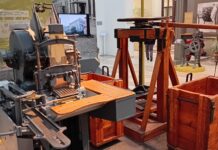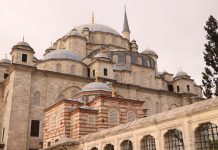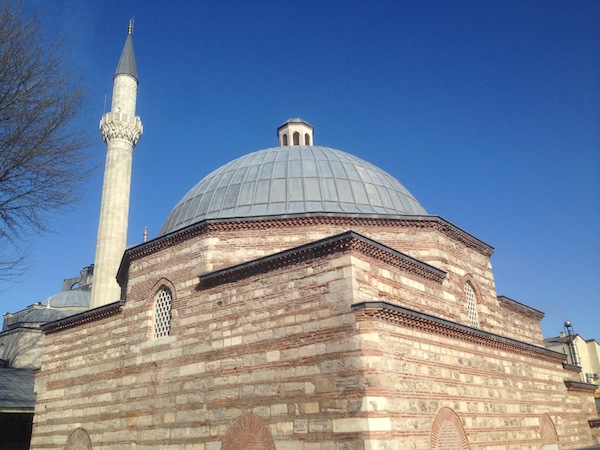
I am fascinated by hamams. Their architecture (those gorgeous holed domes), their history (the ancient ritual of public bathing) and the leisure (they provide a great way to relieve stress) make me one of their biggest fans. I even dared to write a guide for dummies a while ago.
That’s why, when my friends gifted me with a free pass to the Kılıç Ali Paşa Hamam in Tophane for my last birthday, two thoughts crossed my mind: these people really know me, and I have to go try it as soon as I can. So as soon as I got the chance, I made my way to Tophane for a day of relaxation.
The hamam is part of the Kılıç Ali Paşa complex that includes the mosque, a medrese, a türbe and a fountain. This group of buildings was designed by Mimar Sinan and constructed between 1580 and 1587. The complex carries the name of its founder, a corsair who became an Ottoman admiral and whose life was so compelling that even Cervantes mentioned him in his masterpiece Don Quixote.
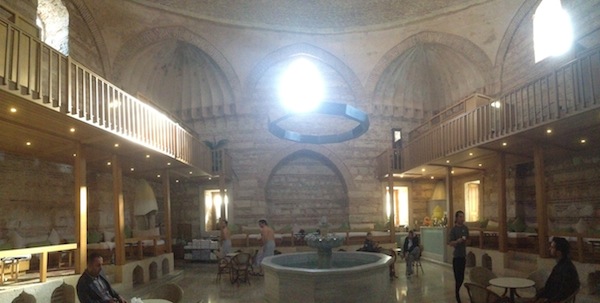
The hamam was built in 1580 to serve the levends, the marine soldiers of the Ottoman Navy. (Fun fact: the name Levent (Levend) came to be applied to the neighborhood because in Ottoman times the area housed a military compound for the Ottoman sailors.) The hamam entrance area is a wide single-dome space that was renovated in 2011 by Cafer Bozkurt. It is one of the largest and most impressive hamam domes in Istanbul. The building was severely damaged over the years and had to go through an intensive renovation to overcome centuries of layered materials, structural damage by water and lack of maintenance. Moreover, the weight of this layered materials caused an uneven settlement on the site that could be potentially dangerous in case of an earthquake.
This single space, the camegah (lounge), is used as a waiting space before entering the hamam and a lounge to rest after enjoying it. Before going into the hot room, you are offered a homemade ayva şerbet, and after the Turkish bath experience you can lay down on the divans that are nestled under the overhang of the second floor. This second floor, which is more like a balcony than a full floor, holds changing rooms where you can take off your street clothes and put on your peştemal (the iconic cotton wrap) and customized sandals.
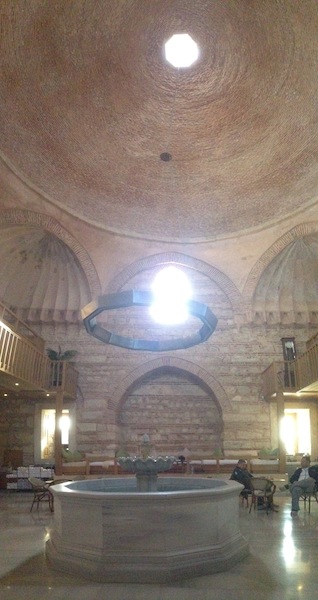
After changing, you enter into the humid area and sit at the kurna, the marble water basin. This helps your body adjust to the heat and humidity of the hamam. There the staff pours warm water over your body, after which you move on to the göbek taşı, the heated hexagon marble in the middle of the hamam space where you lie back and relax. The overall look of the renovated space feels luxurious and contemporary. The lighting is mainly provided by the renovated skylight on top of the dome, while dim lights add to the relaxing and peaceful mood.
When your turn comes, you sit again next to the kurna, and the tellak, the expert masseur, exfoliates your skin with the kese, the scrubbing mitten. Once that ends, the köpük starts: a bubbly soap wash with a loofah that makes you feel like you are in a car wash. My tellak, Orhan, was a skinny guy who turned out to be a therapist and Taekwondo black belt. We had a very entertaining chat while he took care of my tense back and scrubbed off a layer of dead skin.
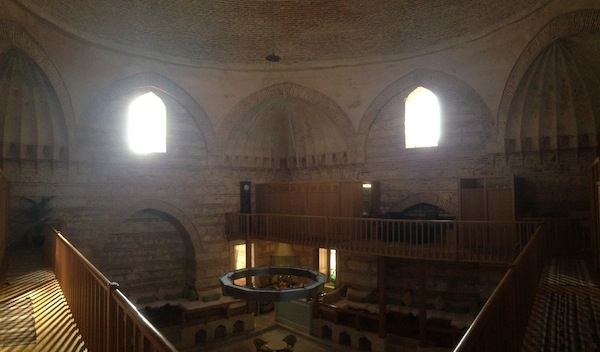
The building was carefully renovated, and it’s an elegant, quiet space even if it’s usually a bit crowded (as a good hamam should be). The interior is impeccable, and it’s probably the cleanest hamam I’ve visited so far. The treatment is also top notch: you have a guide with you every step of the way, you are welcomed at the entrance of the hot room, the staff speaks English and you’re always treated with the utmost respect. I have to admit that it is a remarkably lavish experience.
However, I couldn’t help but feel that it was all a bit aseptic. It’s like the clean version of a song: it’s still good but it feels harmless and not quite the real deal. My verdict? I would highly recommend it for tourists, newcomers and locals who want to have a more high-end Turkish bath. For anyone, like me, who wants to have a more down-to-earth experience, this hamam feels a bit off: it’s almost strange to be treated so well and spoken to in English, even when you try to force them to speak in Turkish. After having gone to the neighborhood hamam for so long, I’ve come to associate the hamam experience with big-bellied, mustachioed men with surly faces almost killing you with their massage. But for an exclusive, classy – albeit slightly more expensive – experience, don’t miss out on this place.
Remember to book in advance as the hamam fills up quickly.
Address: Hamam Sk. No. 1, Tophane, Istanbul
Website: http://kilicalipasahamami.com/
Phone: (0212) 393 8010
[geo_mashup_map]









